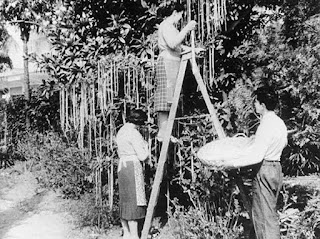Happy April Fools’ Day!
Happy April Fools’ Day!
It was on this day, 1st April, back in ….? when April Fools’ Day was founded. So, what is April Fools’ Day. Well it’s a day when tricks and pranks are carried out, and over the years there have been some classics. In 1957 the BBC reported that Swiss farmers were experiencing a record spaghetti crop and showed footage of people harvesting noodles from trees and in 1998 Burger King advertised a left-handed Whopper.
Now this festival’s origin remains a mystery. Some historians believe it evolved from an ancient Roman festival known as Hilaria, where people dressed up in disguises. Others claim it dates to 1582, when France switched from the Julian calendar to the Gregorian calendar, and people who continued to celebrate it during the last week of March through April 1st became the butt of jokes and pranks. Some even believe it came from Geoffrey Chaucer's The Canterbury Tales, which was published in 1392.
I’ve even read speculation that April Fools’ Day is biblical and comes from the Genesis flood narrative, with Noah making the mistake of sending a dove out of the ark before the water had abated, on the first day of April. So, I guess historically it’s origin will probably always remain a mystery.
April Fools’ Day—celebrated on April 1 each year—has been celebrated for several centuries by different cultures, though its exact origins remain a mystery. April Fools’ Day traditions include playing hoaxes or practical jokes on others, often yelling “April Fools!” at the end to clue in the subject of the April Fools’ Day prank. While its exact history is shrouded in mystery, the embrace of April Fools’ Day jokes by the media and major brands has ensured the unofficial holiday’s long life.
Origins of April Fools' Day
Some historians speculate that April Fools’ Day dates back to 1582, when France switched from the Julian calendar to the Gregorian calendar, as called for by the Council of Trent in 1563. In the Julian Calendar, as in the Hindu calendar, the new year began with the spring equinox around April 1.
People who were slow to get the news or failed to recognize that the start of the new year had moved to January 1 and continued to celebrate it during the last week of March through April 1 became the butt of jokes and hoaxes and were called “April fools.” These pranks included having paper fish placed on their backs and being referred to as “poisson d’avril” (April fish), said to symbolize a young, easily caught fish and a gullible person.
Hilaria
Historians have also linked April Fools’ Day to festivals such as Hilaria (Latin for joyful), which was celebrated in ancient Rome at the end of March by followers of the cult of Cybele. It involved people dressing up in disguises and mocking fellow citizens and even magistrates and was said to be inspired by the Egyptian legend of Isis, Osiris and Seth
Vernal Equinox and April Fools'
There’s also speculation that April Fools’ Day was tied to the vernal equinox, or first day of spring in the Northern Hemisphere, when Mother Nature fooled people with changing, unpredictable weather.
History of April Fools’ Day
April Fools’ Day spread throughout Britain during the 18th century. In Scotland, the tradition became a two-day event, starting with “hunting the gowk,” in which people were sent on phony errands (gowk is a word for cuckoo bird, a symbol for fool) and followed by Tailie Day, which involved pranks played on people’s derrieres, such as pinning fake tails or “kick me” signs on them.
April Fools’ Day Pranks
In modern times, people have gone to great lengths to create elaborate April Fools’ Day hoaxes. Newspapers, radio and TV stations and websites have participated in the April 1 tradition of reporting outrageous fictional claims that have fooled their audiences.
In 1957, the BBC reported that Swiss farmers were experiencing a record spaghetti crop and showed footage of people harvesting noodles from trees. In 1985, Sports Illustrated writer George Plimpton tricked many readers when he ran a made-up article about a rookie pitcher named Sidd Finch who could throw a fastball over 168 miles per hour.
In 1992, National Public Radio ran a spot with former President Richard Nixon saying he was running for president again… only it was an actor, not Nixon, and the segment was all an April Fools’ Day prank that caught the country by surprise.
In 1996, Taco Bell, the fast-food restaurant chain, duped people when it announced it had agreed to purchase Philadelphia’s Liberty Bell and intended to rename it the Taco Liberty Bell. In 1998, after Burger King advertised a “Left-Handed Whopper,” scores of clueless customers requested the fake sandwich. Google notoriously hosts an annual April Fools’ Day prank that has included everything from “telepathic search” to the ability to play Pac Man on Google Maps.
For the average trickster, there is always the classic April Fools’ Day prank of covering the toilet with plastic wrap or switching out sugar and salt.
So have fun, and carry on the tradition.












Comments
Post a Comment